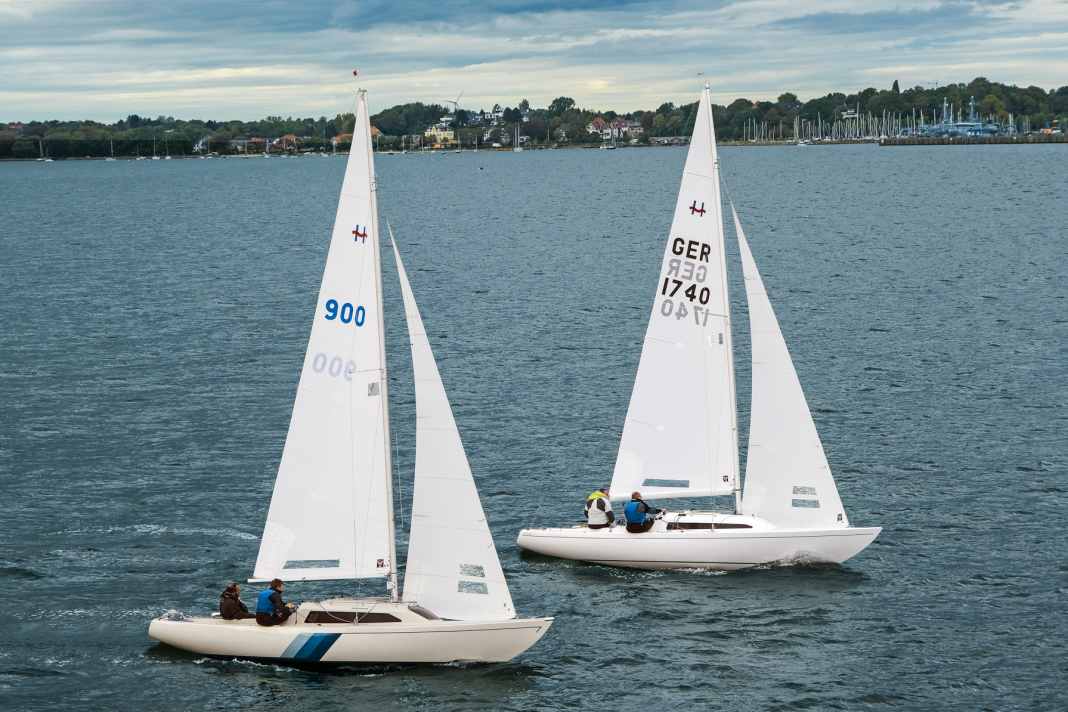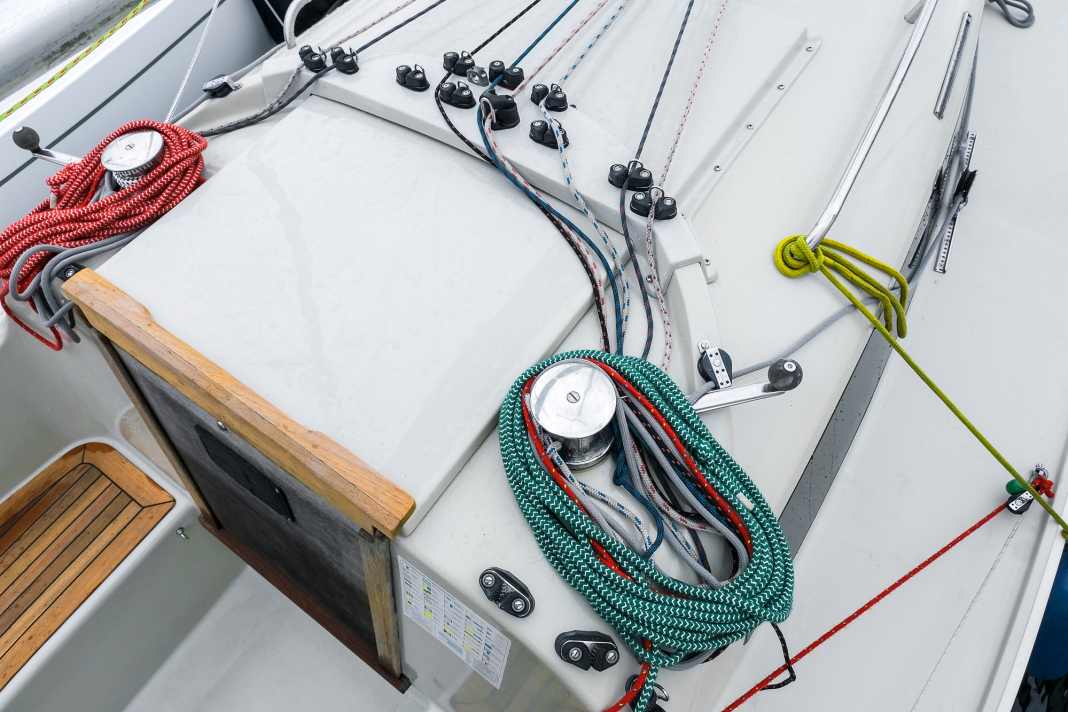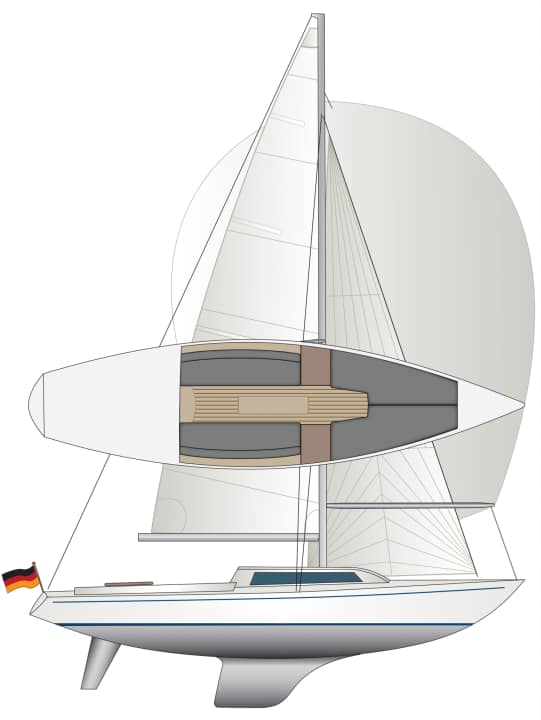





In 1967, the economic crisis, the Vietnam War is raging, Elvis Presley gets married, colour television celebrates its premiere in Germany, the first ATM in England. Marcus Söder, Jürgen Klopp and Boris Becker are born. Vivien Leigh, Che Guevara and Konrad Adenauer die. In Cape Town, Dr Christiaan Barnard transplants a heart for the first time, Formula 1 races its last season without wings.
And in Helsinki, Hans Groop, who works full-time as an engineer and PR manager at the Wärtsilä professional shipyard, designs the boat that bears the initial of his first name. According to other legends, the H stands for the Greek goddess Hestia. She was said to have a rare combination of pronounced beauty and noble reserve. The name will become the programme.
More used boats in the test:
Groop ultimately owed his commission to the Nordic Folkboat, the most successful standardised class to date. In 1967, fibreglass-reinforced plastic was considered an insufficiently researched boatbuilding material. However, Groop had already gained a good reputation as an expert in this field.
The traditional and still very active Helsingfors Segelsällskap club commissioned him to "design a beautiful modern boat, a kind of contemporary folk boat that should not suffer from the limitations of a wooden construction and should sail fast", according to the international class association.
In the first year, 15 ships were built. By 1968, the Finnish manufacturer Artekno was already building 40 units. This was joined by licencees such as Botnia, Elvstrøm, Ol/Ott and later Frauscher in Austria. The first H-boat appeared in Germany in 1973. By then, 500 units were already sailing throughout Europe. In 1976, the new boat was launched at the Kieler Woche. In 1977, she received the blessing of the World Sailing Federation, which was still called the IYRU at the time, to become an international class. To date, around 5300 H-boats have been built. This makes it the second most frequently built habitable keelboat, after the US American J 24, which has been built 5500 times.
H-Boat is a cruiser/racer from the very beginning
Its success is essentially based on its dual use. The boat is suitable for regattas in a fair comparison of standardised classes at a very high level on the one hand and for sporty cruising on the other. The H-Boat is therefore one of the first cruisers/racers. On top of that, it is pretty, affordable, trailerable and seaworthy.
What's more, it is the GRP classic par excellence. Spoon bow and narrow yacht stern, long overhangs and a narrow width speak in favour of it. With a sail load factor of 4.4, it is also well equipped to perform well even in light winds, whereby the narrow waterline width, i.e. small wetted area, also helps. In stronger winds, the high ballast ratio of 50 per cent compensates for the shortcomings of the low dimensional stability. On top of that: The boat wants to be sailed with a layline, then the short waterline length of 6.30 metres of the 8.28 metre long boat increases to promote performance.
Used boat profile
- Type: H-Boat
- Designer: Hans Groop
- Built: From 1967
- Quantity: 5300
- Used boat price: from approx. 12,000 €
- New boat price today: 84.000 €
The underwater hull is moderate. In contrast to the Folke boat, the lateral plan is already divided, but the rudder hangs on a half-skeg and the keel is relatively long. The hull and ballast carrier are connected almost seamlessly; the gentle S-frame of the boat flows further into the keel. The rather large fin makes the boat somewhat cumbersome when tacking and gybing, but contributes to a certain course stability and low drift at low speeds; the H-boat is also great for cruising in narrow waters. It also runs at a very good height. This slender beauty also handles waves well: The V-shaped foreship starts softly.
The rig is seven/eight rigged and does not require backstays. Only a jib and a spinnaker are permitted as foresails in regattas, which is rigged conventionally with a boom. The mast is flexible and easy to trim, the main is sailed without a reef in regattas, in strong winds it can simply be pulled flat and easily opened at the top using a strong backstay tensioner.
The H-boat is also seaworthy and has proven this not only on trips near the coast; even an Atlantic crossing has been documented. For touring, the vessel offers four berths, some storage space and a seat height in the saloon of 90 centimetres (measured without cushions). A washbasin, cool box and toilet can be installed or brought on board as a mobile unit.
Top combination for the H-Boat: moulds from Frauscher, expertise from Saare-Yachts
Despite all its strengths and sailing values: Over the course of time, the advantages of the dual use became less and less important. Regatta sailing was joined by hotter boats, such as the league of various sports boats, heralded by the Melges 24 in the 1990s. For pure cruising, sailors were looking for more comfort and found it in every modern, shorter small cruiser. Ergo: The number of registrations, new builds and activities in the class declined somewhat, at least it was no longer worthwhile for any shipyard to build H-boats - the margin was too small and the cost of building a class-compliant boat was too high.
Thomas Nielsen revitalised the new build. At his shipyard Saare-Yachts in Estonia, which builds comfortable, timeless and very good sailing aft and centre cockpit yachts ranging in size from 38 to 47 feet. A successful H-boat sailor himself for many years, Nielsen wants to help the class, utilise his shipyard to capacity and at the same time be able to sail a new H-boat. To this end, the man from Eckernförde acquired the moulds of the Austrian Frauscher shipyard, which has built recognised fast examples but now only produces motorboats rather than sailing boats.
Hurdles on the way to a new building
Buy a mould and get started? Far from it: "It's not easy. Just one example: according to the class regulations, the boat has to be built from fibreglass mats weighing 680 grams per square metre. But this stuff is no longer available. We were able to agree that we would use the available 650 gram laminate plus another thinner layer," says the Eckernförde native. But that wasn't all. There were no moulds for the keel; these were recreated from old drawings. What's more, the boat is now made with vinyl ester resins, which make it osmosis-resistant and stronger. The Estonian boat builders achieved the total weight of 1450 kilograms almost perfectly. The Saare-H boat turned out to be just four kilograms too light, which is compensated for with counterweights.
Nielsen waited a long time for a building licence: "Coordination with the class association and World Sailing is sometimes difficult, but we get it done." The boat is still a successful combination of sport and a little comfort. What used to pass as an agile touring boat would now be labelled a daysailer. The demands are changing.
The boat also offers an exciting regatta environment. If you want to sail for the tonnes, you will find good competition, especially in southern Germany, Austria and Scandinavia. There are around 1000 H-boats in this country, 150 of which are ranked, and 50 to 70 crews come together at world championships.
The H-Boat is also a good tip when used
The alternative to a new Saare H-boat is a second-hand one. These are available for less than 10,000 euros, while a good one with two sets of sails and a trailer costs between 12,000 and 25,000 euros. However, the buyer should be careful: Osmosis occurred frequently up to the 1985 model year. If you want to be on the safe side, get expert advice or commission a surveyor.
Another typical but easy-to-find weak point is the bilge system, whose hoses may have become porous. Chalked gelcoat on older boats is a purely visual problem that can also be repaired. Boats sailed in regattas can have hairline cracks on the shrouds, but usually come onto the market with many sails.
Whether new or used, the H-Boat is highly favoured by every connoisseur. Thomas Nielsen on his website: "Talk to an H-boat sailor about his time with the boat. He won't stop raving about it and his eyes will light up." He's simply right.
What buyers should consider





The H-Boat is durable, but also has its typical weak points, which are reflected in its value.
Model history
The H-boat was built around 5300 times and by eight shipyards in Northern Europe. However, there were no major changes in the production or design of the standard class type, only minor modifications were made to the deck layout.
Market situation
Used boats can be found for less than 10,000 euros for those who are interested and willing to suffer, with well-maintained examples starting at around 20,000 euros. It is worth taking a look at Switzerland and Scandinavia. Boats used intensively in regattas are often more worn, but come with plenty of sails.
The measured values for the H-boat test





The H-Boat in detail

Technical data of the H-boat
- Design engineer: Hans Groop
- Torso length: 8,28 m
- Waterline length: 6,30 m
- Width: 2,18 m
- Depth: 1,30 m
- Weight: 1,45 t
- Mainsail: 14,8 m2
- Fock: 10,2 m2
- Spinnaker: 36,0 m2
- Yardstick: 106
Hull and deck construction
Hull GRP full laminate, deck foam sandwich. Vinyl ester resin. Deck-hull joint laminated over
Price and shipyard
- Base price new ex shipyard: 84.900 €
- Guarantee/against osmosis: 2/5 years
As of 04/2024, how the prices shown are defined can be found here!
Shipyard
Distribution
Yachtsport Eckernförde, Tel. 04351/75 27 34; www.yse.de
YACHT rating of the H-boat
The H-Boat is regatta and cruising capable, seaworthy, trailerable, robust and durable, and it sails superbly. All in all, a hit package
Design and concept
- + Proven timeless design
- + Good distribution
- - Little space in the cockpit
Sailing performance and trim
- + Sails fast and high
- + Softly inserts into the shaft
- + Trim and control sensitive
- - Not slippery
Living and finishing quality
- + Habitable (camping standard)
- - Little storage space outside
Equipment and technology
- + High-quality components
- + Good trimming facilities
The article first appeared in YACHT 25/2020 and has been updated for the online version.

